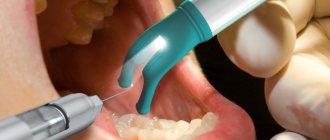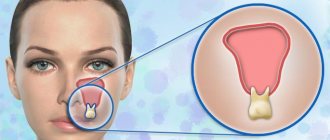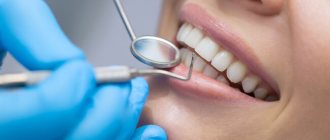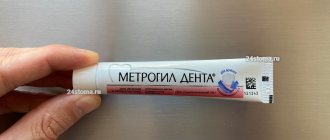Pain after tooth extraction
After the tooth is removed and the anesthesia wears off, the patient may experience minor pain, which usually goes away quickly. However, sometimes 1-3 days after surgery a sharp pain appears in the area of the socket of the extracted tooth .
Taking analgesics does not bring relief. This pain most often occurs due to disruption of the normal healing process of the tooth socket. In addition, the pain may be caused by the remaining sharp edges of the socket or by an exposed area of the alveolar bone not covered with soft tissue.
Pain in the tooth socket after extraction
If the tooth extraction operation is adequately carried out and all the dentist’s recommendations are followed, then after a couple of days the tooth socket should heal painlessly. A plaque forms at the site of damage, which is gradually covered by epithelial tissue as new bone tissue begins to grow.
And if pain persists after these days, it means that due to a combination of circumstances, inflammation has begun in the injured area (alveolus). In medical terminology, this process is called post-extraction alveolitis or alveolitis of the socket.
Etiology of alveolitis
After the tooth is removed, the created cavity should be filled with blood, which after a short time will transform into a special blood clot. Such a clot forms a biological barrier against all kinds of mechanical damage and infection.
But in some cases, the integrity of the blood clot is disrupted or for some reason it is completely absent, then the healing process is disrupted. In this regard, the development of alveolitis of the socket begins, which appears already on the third day and is accompanied by pain.
The main reasons for its occurrence and development are considered to be:
- Incorrectly performed surgery with violations of antiseptic rules, involuntary involvement of dental plaque in the socket, etc.
- Insufficient treatment of the postoperative socket, as a result of which small particles of tooth or pathological tissue remain in it.
- Complexity of the operation.
- Insufficient or complete absence of outpatient procedures for oral care recommended by a doctor.
- Failure to comply with simple hygiene standards.
- Eating food (especially spicy, hot or rough) before the recommended time.
- Self-medication by rinsing on the day of removal.
- Smoking in the first hours after tooth loss.
- Weak immune defense of the body.
- A number of common diseases that can affect the development of the inflammatory process.
Post-extraction alveolitis is dangerous due to severe consequences and complications. Therefore, this procedure must be approached responsibly and trusted to experienced and adequate specialists.
Symptoms and their manifestation
Usually, with a “dry” socket (no blood clot), the inflammatory process begins quite quickly after removal. Residues of food and saliva may be observed in an unprotected formation. Redness of the nearby gums is noticed, touching which causes pain.
If you do not seek medical help in time, the symptoms become more noticeable and are accompanied by:
- not soothing, rather severe pain in the damaged area;
- general condition worsens with rising temperature;
- a feeling of pain spreading throughout the entire jaw;
- the appearance of pus in the wound, resulting in a purulent odor from the mouth;
- formation of black plaque on the gum and socket;
- The submandibular lymph nodes gradually enlarge.
Emergency treatment at home
If the first signs of alveolitis appear and you cannot see a doctor within two to three days, you can try to alleviate the symptoms of the disease yourself.
It is important to remember that not all methods, drugs or folk remedies can cause relief. Some may even make the condition worse. For example, such well-known antiseptics as hydrogen peroxide or soda, on the contrary, will clean the infected hole beyond recognition, freeing it from blood clots, so that it will remain completely defenseless for infections.
If you can contact a specialist, you can use some types of analgesics to relieve pain. These include Baralgin, Ketanov or something similar. To relieve inflammation, you can rinse with a weak solution of potassium permanganate or furatsilin.
But natural antiseptics can be the most effective at home. Consider some folk recipes that have worked well for this disease.
Remedy No. 1
The herbal mixture has a good effect. Flax seed, blessed knycus, creeping tenacious (grass), blue cornflower (flowers), oregano, sunflower petals, are crushed and mixed in equal proportions. Then a spoon (tablespoon) of the crushed collection is filled with one glass of boiling water. The hour is running out. The strained mixture is divided into 4 doses and drunk throughout the day. Good reviews when using this decoction in the form of inhalation.
Remedy No. 2
Pour two tablespoons of St. John's wort (herb) and a spoonful of chamomile (flowers) into half a liter of boiling water and leave covered for two hours. Strain the resulting mixture and rinse your mouth with it at least every hour.
Remedy No. 3
A spoonful of medicinal sage is poured into a glass of boiling water. Brew for an hour in a thermos or wrapped in a thick thick cloth. After straining, rinse your mouth as often as possible throughout the day.
Remedy No. 4
A spoonful of dried chamomile flowers is poured into a glass of boiling water and steamed in a thermos for half an hour. Carefully filter and use as a rinse throughout the day.
Remedy No. 5
A decoction made from calendula (flowers) has an effective effect. A spoonful of flowers is poured with 200 ml of boiling water and steamed for half an hour. Then strain and rinse all day.
Of course, traditional methods of treatment can be effective, but it is better not to do without consulting specialists.
Alveolitis
Inflammation of the walls of the socket.
- In the initial stage of alveolitis, an intermittent aching pain appears in the socket, which intensifies while eating;
- The general condition is not disturbed, the body temperature is normal;
- The tooth socket is only partially filled with a loose, disintegrating blood clot.
With further development of inflammation:
- The pain intensifies and becomes constant;
- Transmitted to the ear, temple, corresponding half of the head;
- The general condition worsens, malaise and fever appear.
Limited osteomyelitis of the tooth socket
Inflammation of the bone tissue in the area of the extracted tooth :
- in the socket of the extracted tooth , and pain occurs in the adjacent teeth;
- Weakness, severe headache;
- Body temperature is 37.6-37.8°C and above, sometimes there is chills;
- Loss of sleep and performance;
- The bottom and walls of the hole are covered with a dirty gray mass with a fetid odor;
- Touching the gum is sharply painful;
- When you tap adjacent teeth, pain occurs;
- The perimandibular soft tissues are swollen, the submandibular lymph nodes are enlarged, dense, painful;
The symptoms of acute inflammation last 6-8 days, sometimes 10 days, then they decrease, the process passes into the subacute and then into the chronic stage.
- The pain becomes dull and weak;
- General condition improves;
- Body temperature normalizes;
- After 12-15 days, the tooth socket is filled with loose, sometimes protruding pathological granulation tissue, which, when pressed, releases pus.
Please note that pain relief during a complication does not mean that the process has begun to heal; perhaps it has entered a chronic, more dangerous stage. As a rule, the surgeon schedules a follow-up examination for the patient after removal; ATTENDANCE IS MANDATORY!
help yourself
Typically, surgeons do not recommend doing anything with the wound that remains after tooth extraction. But pain does not have to be endured, especially for people who have a low pain threshold. There is a whole arsenal of remedies, from official medications to folk remedies, that can reduce pain and alleviate the plight of a patient who has lost a tooth.
- How long does it take for drugs to leave the body?
Table. Medicines to relieve pain after tooth extraction
| A drug | Action |
| Ketorolac (and analogues with identical active ingredients) | The drug is potent. The pain is relieved within 20 minutes. Moreover, it copes even with severe pain. Lasts effect for 6 hours. Can be taken up to 4 times a day. |
| Nimesulide | Refers to super potent drugs. The pain goes away within a quarter of an hour. This drug should not be abused. |
| Analgin | It is not considered a serious anabolic that helps with toothache, but it successfully relieves pain of mild to moderate severity. |
| Baralgin | Even softer and weaker in action than analgin. Effective only for mild and non-intense pain. |
| Spasmalgon | It has rather weak anabolic properties, but at the same time has an anti-inflammatory effect, so it is preferred for moderate and mild pain to analgin and baralgin. |
Each person is used to dealing with pain using their own methods. For some, only a group of ketorolac helps, while others are completely satisfied with baralgin. And for some people it is not necessary to take potent drugs with a lot of side effects - simple folk remedies are enough.
People's Arsenal
The simplest, most harmless and effective remedy, it can be used by everyone without exception to relieve post-operative toothache - a cold compress . Effective in the first day after removal. In many private clinics, the patient is sent home after surgery with an ice bag applied to the cheek. At home, it is good to use ice in which just water or a decoction of medicinal herbs is frozen. Any item from the freezer will do, such as a piece of frozen meat. Just wet the towels with cold water, apply them and change them as soon as they reach body temperature. There is a cooling patch in the pharmacy that has the same effect as a compress - it freezes the nerve endings and relieves pain.
Cold compress
Important! Rinses during tooth extraction can be used only after three days after the operation. And then these should not be rinses, but rather baths. Take a herbal decoction or saline solution into your mouth, hold it without unnecessary movements of the liquid, and spit it out. All this is to quickly relieve inflammation, but not to move or wash away the blood clot.
A remedy that will not cause harm, but only benefit, is propolis. It has strong antibacterial properties, therefore, to normalize and disinfect the microflora in the mouth, it is recommended to hold a piece of propolis in the socket of an extracted tooth.
Propolis
Sharp edges of the alveoli
Socket pain can be caused by protruding sharp edges of the socket, which injure the mucous membrane located above them. Pain appears 1-2 days after tooth extraction , when the edges of the gums above the socket begin to approach each other.
- The pain intensifies during chewing and when touching the gums;
- When you feel the hole with your finger, a protruding sharp edge of the bone is detected, and a sharp pain occurs.
This pain can be distinguished from the pain of alveolitis by the absence of inflammation in the socket area and the presence of an organizing blood clot in it.
Why does a pulled out tooth hurt?
Toothache from removing the “subject of pain” - a damaged tooth - is not supernatural. Tooth extraction is considered a surgical operation according to all medical standards. Damaged living tissue of the gums and oral cavity can cause pain even greater than what the patient experienced from inflammation or decay of a diseased tooth.
Removal of a tooth
Soft tissues are known to have many nerve endings. The gums and mucous membranes are literally riddled with nerves, which, when acted upon, transmit pain impulses to the brain. When the patient receives local anesthesia, the nerve endings temporarily atrophy and cease to fulfill their duties - to carry pain to the body cells. But then the anesthesia ends, and the nerve endings begin to work. Aching, dull pain that interferes with normal life continues, as a normal reaction to surgery.
How normal is this, and how “according to the rules” should a tooth hurt after extraction? Weak. Not too intense. As it fades away. No more than three days. Patients who are particularly sensitive to injury and have a low pain threshold are given four days.
Aching pain can last up to four days
Important! If on the fifth day after tooth extraction the pain in the gums continues and its intensity does not decrease, on the contrary, it increases, you should consult a doctor.
Toothache after caries treatment
Constant pain after filling can occur for many reasons. A common cause of discomfort is the application of an insulating lining made of glass ionomer cement (GIC) and filling on the same day with a composite. The polymerization times of GIC and composite differ, which can result in displacement of the gasket and its pressure on the pulp.
If the pain is short-term in nature as a reaction to cold, sour or sweet and quickly passes after removing the irritant, it may be due to the fact that during the treatment there was a mechanical effect on the pulp. After 2-3 days, the pulp will return to normal functioning and the pain will stop.
If you experience pain when biting, you need your dentist to grind the filling to fit your bite.











